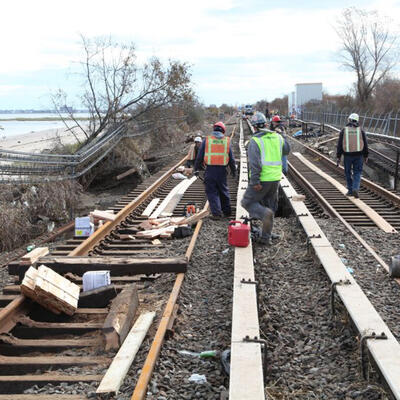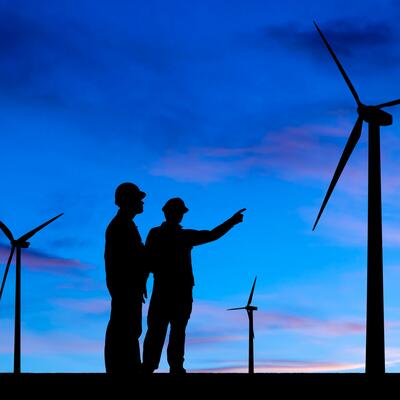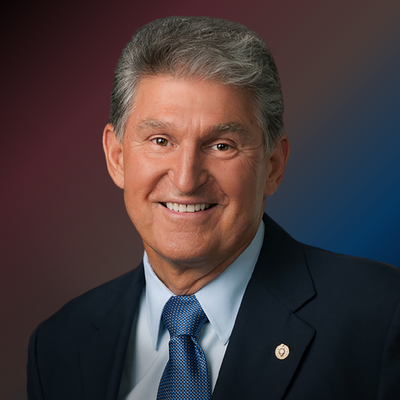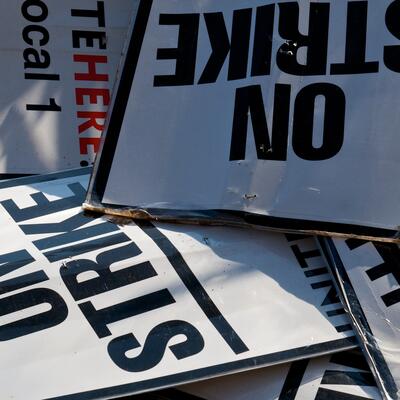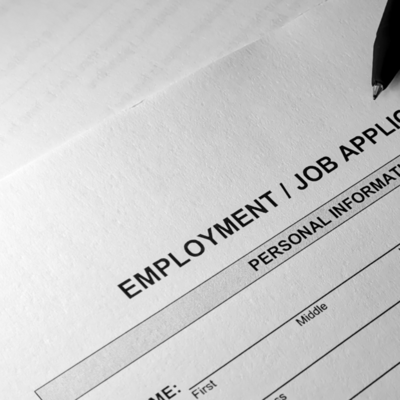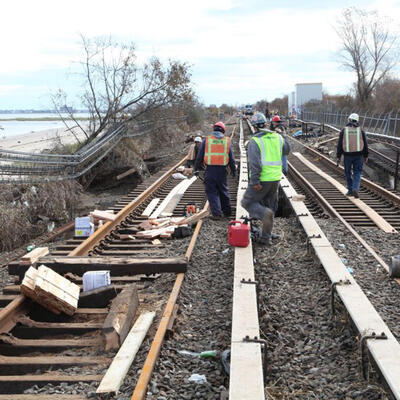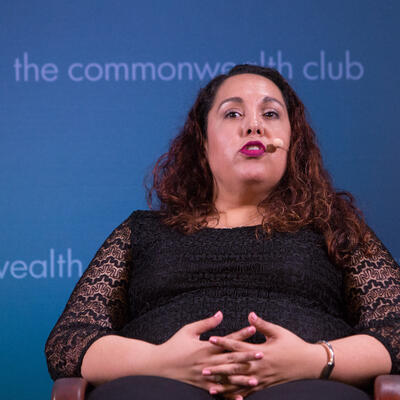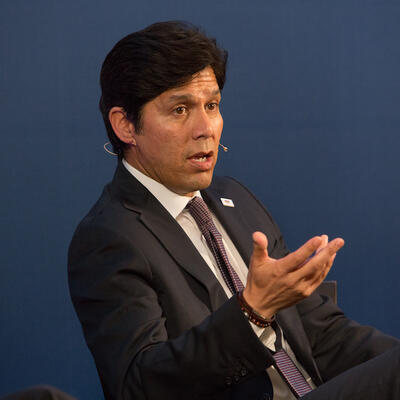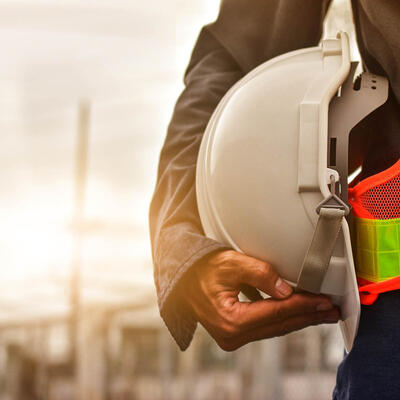
State of the Unions: Navigating Job Creation and Destruction
Guests
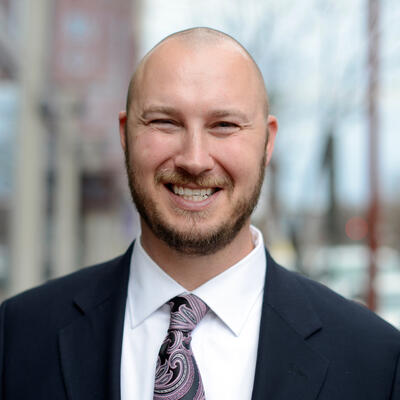
Austin Keyser

Yvette Pena-O'Sullivan
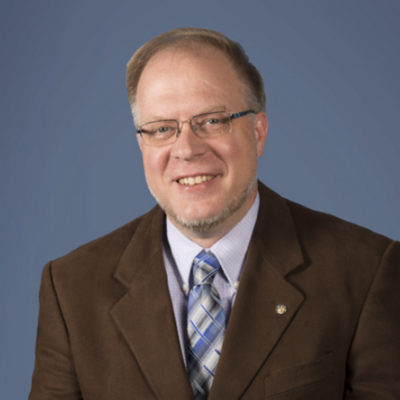
Lee Anderson
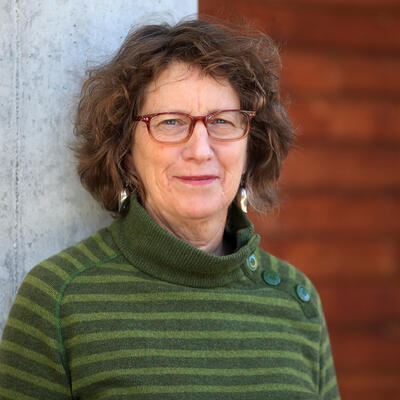
Carol Zabin
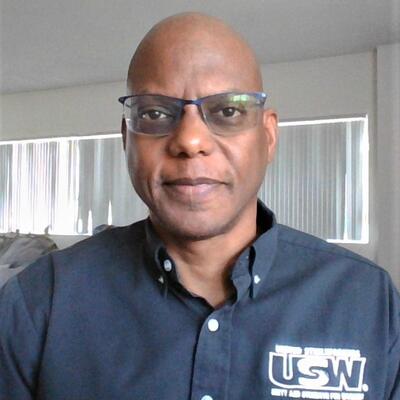
Norman Rogers
Summary
Transitioning to renewable energy is an essential, and massive, part of addressing the climate emergency. But that transition will bring major disruption to the fossil fuel industry.
A large coal or nuclear power plant can employ hundreds of people, while solar or wind farms, once operational, typically employ a couple dozen or fewer. Green jobs have also typically been nonunion, paying less than fossil fuel jobs. According to the Bureau of Labor Statistics, the median wage for a solar installer is about $45,000 a year, while a skilled worker at a coal plant may make $82,000 a year.
As President Biden centers his climate plans on jobs, labor unions are jockeying for position in the clean energy economy.
The International Brotherhood of Electrical Workers supported Trump’s rollback of Obama’s Clean Power Plan because many members work at coal plants. But in 2020 the union endorsed candidate Joe Biden, and the union is firmly behind much of the president’s climate agenda. While recognizing that climate change is a threat, the Laborers’ International Union of North America and the Utility Workers Union of America are skeptical of promises of a just transition.
“You can’t tell someone who’s been working…over 25 years, trained to work in a [fossil fuel] plant, oh, you’re gonna go build a wind farm; it doesn’t work that way,” says Yvette Pena-O'Sullivan with the Laborers’ International Union of North America. “But I think that our policymakers and our lawmakers have really woken up to the fact that it's not that simple. It’s important to have workers at the table, to have unions at the table, the communities at the table, to see how exactly we can transition the economy and do it smartly, slowly, knowing that we’ve got climate goals that we have to achieve, because we all do care about climate change. But doing so in a way that’s not gonna hurt working families everywhere.”
As some carbon-heavy plants and industries shut down, many unions are concerned about job losses, and what follows.
“It’s not just that a job is lost, it's that maybe now you’ve got to move two states away to get another job and pretty soon your community is emptied out and there’s this diaspora of families and communities,” says Lee Anderson, director of government affairs for the Utility Workers Union of America. He says that can lead to a rise in social ills, like addiction and abuse.
Austin Keyser with the International Brotherhood of Electrical Workers says the increasing frequency of climate disruptions underscores the need for a systems change, so long as workers are supported.
“There's no doubt that there’s climate change, whether it’s coastal, major storms in places like Iowa that’s just damaging crops and destroying all sorts of things and major winter storms that are more frequent. And we don’t want to continue to see that happen. But we also know there’s major infrastructure investments that have to happen here in order to defend against what’s happening,” he says. “Build Back Better is the first real industrial policy proposal that this country has seen, a comprehensive industrial policy.”
Carol Zabin, director of the Green Economy Program at the UC Berkeley Labor Center, says union support can help speed up state and federal policy development and implementation as this transition occurs.
“As we develop the specific policies to address greenhouse gas emissions in all sectors of the economy… we really have to incorporate labor standards and labor policies that result in good jobs in those industries that we are trying to change,” Zabin says, as well as creating pathways into those good jobs for those who have been excluded to ensure racial equity. Zabin says we need to deal head-on with the displacement of fossil fuel workers by “keeping them whole” depending on the stage of their career.
“And they have to be at the table in terms of economic diversification in their communities. They need a voice and they need to feel like they are part of this future economy and not just stuck in the old fossil fuel dependent economy,” Zabin says.
This episode was supported in part by The ClimateWorks Foundation.
Related Links:
Full Transcript
Greg Dalton: This is Climate One. I’m Greg Dalton. Addressing climate change means overhauling all the systems around us:
Austin Keyser: There are certain things that are such critical infrastructure that we have to invest in quickly, fast, now to mitigate against the climate change that we are seeing.
Greg Dalton: But that transition will disrupt the fossil fuel industry. Many unions are concerned about job losses, and what follows.
Lee Anderson: It’s not just that a job is lost, it's that maybe now you’ve got to move two states away to get another job and pretty soon your community is emptied out and there’s this diaspora.
Greg Dalton: So how can we protect workers as they navigate through job destruction AND creation?
Yvette Pena-O'Sullivan: It's really about trying to make sure that whatever those 20 million jobs have been created are ones that are highroad hopefully union just good paying jobs and ones that we can, you know, be proud of and ones that the workers feel like they can provide for their families.
Greg Dalton: State of the Unions, Up next on Climate One.
Greg Dalton: How can unions help protect workers during the energy transition? This is Climate One, I’m Greg Dalton. As President Biden centers his climate plans on jobs, labor unions are jockeying for position in the transition to clean energy. The International Brotherhood of Electrical Workers supported Trump’s rollback of Obama’s Clean Power Plan because many members work at coal plants. But in 2020 the union endorsed candidate Joe Biden, and the union is firmly behind much of the president’s climate agenda. While recognizing that climate change is a threat, other unions are skeptical of promises of a just transition, saying green jobs are typically non-union and pay far less than fossil fuel jobs.
Greg Dalton: I’ve invited three guests to discuss this transition. Austin Keyser is assistant to the International President for Government Affairs at the International Brotherhood of Electrical Workers. Yvette Pena-O'Sullivan is executive director of the Office of the General President with LiUNA, Laborers' International Union of North America, and Lee Anderson is director of Government Affairs with the Utility Workers Union of America.
Today’s episode was supported in part by The ClimateWorks Foundation.
Greg Dalton: In my recent conversation with Silicon Valley venture capitalist John Doerr, he said that the transition to a clean energy economy will destroy 5 million jobs in some areas but create 20 million jobs in others. I asked Yvette Pena-O'Sullivan to react to those figures.
Yvette Pena-O'Sullivan: So, we’ve really got to look at very closely the kinds of jobs that’ll be lost. It’s not oh, 5 million jobs gone. These are 5 million workers that work hard every day who’ve train for the jobs that they’re in and who provide for their families. And it’s really about trying to make sure that whatever those 20 million jobs have been created are ones that are high road, hopefully union just good paying jobs and ones that we can, you know, be proud of and ones that the workers feel like they can provide for their families. And so, I guess my answer to him is what kind of jobs you’re talking about and that’s really what I think all of us are always fighting and working towards just making sure that the jobs that are created are good jobs.
Greg Dalton: Yeah, there’s the statistical macrolevel and then there's the human level. It’s not like you just walk across the street and get a new job. Lee Anderson, let's drill into that, you know, how many permanent jobs say, are in a coal plant compared to a wind or solar farm producing the same amount of energy? I know there’s construction jobs, but I'm talking about permanent jobs. Give us a sense of coal and methane gas versus wind and solar.
Lee Anderson: It depends on plant size of course, but if you’re talking about a really large coal-fired power plant that will employ hundreds of people, you know, 400, 500 people for a really big one. If you’re talking about the nuclear plants, that's hundreds for sure. Gas-fired power generation is probably gonna be much, much less most of those you can run with a couple dozen people. We actually have an apprenticeship program we trained people to work on renewable power generation. We have techs who do wind, solar and battery storage technical work. We represent every utility wind tech in the state of Michigan. That’s 50 people who are utility wind techs in the entire state of Michigan, represent all of them. There are others of course who are non-utility that’s a different subject. The point there is that a single coal plant closure will displace hundreds of people and for the kind of jobs you’re talking about the permanent operations and maintenance jobs there just aren't that many it's just the way the technology is.
Greg Dalton: So, something like I heard something like one-sixth or just like a small fraction of coal or fossil fuel plant will, you know, the comparable permanent jobs that wind or solar will be a small fraction of what the fossil generation is, is that right?
Lee Anderson: That’s correct, yes.
Greg Dalton: Green jobs typically have been nonunion, paying less than fossil fuel jobs, according to the Bureau of Labor Statistics, the median wage for a solar installer is about $45,000 a year, while a skilled worker at a coal plant may make $82,000 a year. Yvette Pena-O'Sullivan, what’s the potential for closing that gap
Yvette Pena-O'Sullivan: So, to close the gap again we have to be careful with comparing the jobs, Greg, because in some cases you can't compare them. But our goal and our focus for example, let’s say in the renewable sector is to organize and lift the wages of the renewable sector because currently nonunion makes about 30% less than union. And so, something that we have advocated strongly for is for example, the investment tax credit and the production tax credit, which the renewable sector relies heavily on; in the past as they’ve been getting these extensions, they’ve done so without any kind of labor protections or wage or anything. It’s just been basically blank checks for the sector, thereby really making it much more difficult to organize and to unionize. Beginning of 2021, we’re looking at the largest wind farms that were being built, most of them were nonunion. The top 10 I should say, were nonunion except one. We need to look at the new numbers and see how we even prove but that just sort of gives you a taste of the challenges that we’ve been feeling. So, one of the policies that we’re really excited about and, you know, hopefully we'll see parts of the Build Back Better agenda passed. There have been discussions on perhaps having the climate elements that are in there maybe move on their own which would include some of these production tax credits and investment tax credits. And hopefully they will have those legal protections that we've all worked really hard towards. And we think that it will put the whole industry in a better path to see better numbers and hopefully more family sustaining wages.
Greg Dalton: Right. And, Yvette, staying with you, we hear a lot of activists and politicians advocating for a just transition. What does that mean to you and how do you feel about that term, just transition?
Yvette Pena-O'Sullivan: So, Greg, I’ve had a love hate and a little bit of love again and hate again relationship with that term. And mainly because I think that folks have evolved a little bit in how they’ve used it. I think a little bit like what I was saying before it was sort of this blanket solution, this new green economy is being built just transition don't worry, we’ll just retrain those workers and put them into these new jobs. And that would make us shudder because you can’t tell someone who’s been working in a sector like what Lee was saying for, you know, over 25 years trained to work in a plant, oh, you’re gonna go build a wind farm, it doesn’t work that way. And you’re gonna make less than 30%, I mean, you know, 50% more than what you're making. That is not a just transition. But I think that our policymakers and our lawmakers have really woken up to the fact that it's not that simple. It’s important to have workers at the table to have unions at the table, the communities at the table to see how exactly we can transition the economy and do it smartly, slowly, knowing that we’ve got climate goals that we have to achieve because we all do care about climate change. But doing so in a way that’s not gonna hurt working families everywhere. I think we’re in a better place as we discuss how to transition economies and workers. But it’s something that we have to be careful about.
Greg Dalton: Lee Anderson, when some trades stand to see job growth and others losses how do you resolve those conflicts? It seems like there's clearly tension between the emerging economy and the workers there and the fossil fuel workers and what they're trying to maintain?
Lee Anderson: First of all we had to acknowledge that tension is very real, right. And these aren’t statistics; these are human beings out there embedded in communities and have families, their whole life. And some of these people stand to lose everything they’ve got because of these changes, right. So, that tension is not made up, that's a very real thing. And unfortunately, it’s not susceptible to easy resolution otherwise we have done it a long time ago. And, unfortunately, of course as we do more and more of these things the energy systems of all and even more ways including transportation and all that the problem only grows larger. We assume we’re talking about millions of people being displaced in various ways. And to build on what Yvette said about transition that’s a topic I’ve actually spent most of the last decade of my life on. There are policies out there and there are things that we have worked on there are things that we have work on this year to try and get into the Build Back Better plan. But ultimately, did not make it in there because of political obligation that we talk about. And so, the net result of that is that there really is not any national policy at all to address that issue. And there is a historical example that we talk about there are other nations who are doing certain things about it. But here in the US there really is no plan for that. And so, the things unwind about the way that you think they would which is chaotically and randomly and they cause massive economic and social and ultimately political disruption. It’s not just that a job is lost, it's that maybe now you’ve got to move two states away to get another job and pretty soon your community is emptied out and there’s this diaspora of families and communities. And that’s why when you look across the landscape you see all these places that I would term, you know, former communities they’ve emptied now, right. Power plants are just one more iteration of that deindustrialization and the results are pretty plain to see.
Greg Dalton: And what are some of the solutions that you try to get in, or other unions have try to get in recently and who was opposing them?
Lee Anderson: Well, that’s quite a story. I spent most of the last year all day every day trying to make that happen. Look, we worked up some specific policy proposals that we sort of imported from other countries. Specifically, Germany and Canada where they’ve taken a national approach to it. Canada's success is mixed. Germany I think is doing better. But we got the ideas and said look, the main thing that gets people in trouble is they go out of the power plant or the mine for the last time and they’re in a jam, right? And they need something now immediately because the bills don’t stop coming. They got to pay the mortgage, right, the kids still need asthma medicine. And so, they will run to the first job they can get a hold of, right. Oftentimes just because they need to get back on healthcare, right? A lot of times that ends up being I’m gonna go get a commercial driver’s license to drive a truck. And the reason is I can do that very quickly. It takes about six weeks, right? So, we said look, you got to give people time. And so, we put forth a policy proposal that covers five years. And for five years we’re gonna keep you whole on your pay on your retirement benefits that’s, you know, pensions 401(k)s social security benefits. We’re gonna keep you whole on your healthcare, right, make sure you don’t lose that. And we’re gonna offer a full education benefit. We’re just not like training, right, like if you want to go and get a CDL or go learn how to weld or something and that’s good for you as an individual, great. But if on the other hand you wanna go to West Virginia University and get a four-year degree if that’s what’s right for your circumstance you should do that to offer that. And this was an idea that we got from the senator that we work with. We’re also gonna offer that education plan to your children. And the idea there is that you break that cycle of poverty that people can otherwise fall into. They just lost one of the best jobs in the economy, right, let alone one of the best jobs in their community, right. Okay, so you take that suite of benefits you give it to them for five years, and you say we got you here and you have real time and real benefits to sort things out for what’s gonna make sense for you as an individual. And that’s different for every person everybody walks out of the plant with their own algorithm to solve. Skill set where they are in life where they live et cetera.
Greg Dalton: So, it sounds like good ideas. Who came up and opposed it?
Lee Anderson: So unfortunately, yeah, there was ultimately a conversation had inevitably with Senator Joe Manchin of West Virginia. And he was opposed to these concepts, right, he just could not find a way forward to support them. And so, we made it that far, the next step was to move that stuff into the actual Build Back Better Act. Didn’t happen because of that opposition. And now, you know, everything is so, you know, are we gonna do anything at all it looks like, it’s incredibly unlikely that that will move forward.
Greg Dalton: You’re listening to a Climate One conversation about the role of unions in the clean energy transition. If you missed a previous episode, or want to hear more of Climate One’s empowering conversations, subscribe to our podcast wherever you get your pods. Coming up, the nuances of how the energy transition affects workers across industries:
Lee Anderson: Do you work in a coal plant, a gas power plant, you work in a nuke. Do you work on gas distribution? Wherever you are in that system, that evolution looks different to you, right? To sort of say that this one thing threatens that one thing… there are a lot of moving parts there that are changing.
Greg Dalton: That’s up next, when Climate One continues.
Greg Dalton: This is Climate One. I’m Greg Dalton. We’re talking about the energy transition from fossil fuels to clean energy and the implications for American workers. My guests are Austin Keyser with the International Brotherhood of Electrical Workers, Yvette Pena-O'Sullivan with Laborers' International Union of North America, and Lee Anderson with the Utility Workers Union of America. As this transition happens, Austin Keyser says some workers are more vulnerable than others.
Austin Keyser: I mean the people that can get hurt the most are the people like mine and Lee’s members who work in these utility plants. But not only that but the construction workers who work refueling. So, Lee was talking about how many workers are on a coal-fired power plant. Those are the employees of the plant, right. There’s constantly capital improvement projects going on at these plants. There’s refueling in the nuclear industry so there’s a massive number of contract hours that also go to those and really drive the construction workforce. And because they’re such sophisticated jobs they keep their workforce highly skilled, right. Prepared to do heavy industrial work of all forms, not just in the power plants. So, the loss of those hours really hurts, that hurts money going into training funds, that hurts money going into pension funds and it hurts the economy writ large. And, you know, I won’t go too far into it but I’m from a community, Portsmouth, Ohio which Lee knows well because he’s had, what five units go down just in the last couple of years in that area. But you take a community that was once just a thriving middle class now the biggest employer is the hospital, how’s the hospital growing as the population shrinks, right. It’s growing like crazy because all sorts of health and social ills are popping out. The second biggest employer I think is the drug rehabilitation center which is buying up old factories to make them residential inpatient centers and then the prison. So, a place where we’re gonna benefit is in transmission lines, you know, no matter what happens here there’s gonna be a massive buildout we think we’re gonna need a hundred thousand more power linemen over the next decade. And so, that’s a big thing these guys are making over a hundred thousand dollars a year, they’re great jobs. But they’re transient jobs, right, you’re building them as you go through communities, right. So that’s big. Manufacturing stands to gain a bunch. Just a couple decades ago IBEW had nearly 400,000 workers in advanced manufacturing in the United States. We have 30,000 now because it was advanced manufacturing mostly in the energy and electronic sectors. And those are the jobs that were hemorrhaged the fastest, right, those are the ones we lost first. And so, trying to bring and re-domesticate a lot of that back into the United States, and whether we site those on brown fields or whether we bring hydrogen to these brown fields or whether we do, you know, we figure out how to do carbon capture and save some of these plants we definitely need to keep the nuclear power plants online and build more of them, at least the advanced reactors. So, there’s a lot of places that can go here. We’re gonna lose on rail, you know, rail is hard, rail moves a lot of coal it moves, you know, heavy stuff. So, we’ve got to figure out how to retool and how to reuse rail. So, we liked a lot of the proposals I’m trying to bring more passenger rail to the United States, a lot of the investments that the Biden administration has been talking about. So, there’s a lot of room to gain here but it is shifting and we have to be very cognizant that we look at these place-based strategies and that we put jobs in the communities that are going to lose. That’s why it’s so disappointing that, you know, Manchin wouldn’t get on board with us for worker retention. Retaining workers at say, American electric power in West Virginia is a significant number of jobs and those are the highest paying jobs and almost everyone in the communities they existed they drive the economy they raise all the money for the United Way, you know, they have a compounding factor like 7 to 1, so they’re supporting all the other jobs in the economy.
Greg Dalton: One of the biggest energy stories in the last decade is fracked methane undercutting coal on price in the marketplace. Texas frackers expanded the supply, drove prices down, and arguably have done more to close coal plants than Mike Bloomberg and the Sierra Club. Lee Anderson, what has been the impact on workers of that fuel switching from coal to methane?
Lee Anderson: Oh, well, you’re touching on something incredibly complex. Look, the entire energy system is evolving in a whole set of different ways. And what you think about that depends on where you stand, right? Do you work in a coal plant, a gas power plant, you work in a nuke. Do you work on gas distribution? Wherever you are in that system, that evolution looks different to you, right? To sort of say that this one thing threatens that one thing there are a lot of moving parts there that are changing. So, yes of course there are examples where this group of workers feels threatened by what’s happening over here or this, you know, this over here. But there’s no way to really parse that apart. Evolution is very complex and that’s why it’s going to impact, you know, a lot of people in a lot of places. And while we have to think about, you know, in broad terms how do we manage this evolution generally because really coal is just the very beginning of it, right. We haven’t even spoken about transportation. That’s now the largest source of emissions, right, not power generation.
Greg Dalton: US production of methane gas is about 50% higher than it was a decade ago. That's good news in a sense of gas burns a lot cleaner than coal. But methane leaks are undercounted in a massive problem. Methane is 80 times more damaging to our climate than carbon dioxide. Yvette Pena-O'Sullivan, LIUNA supported a Pennsylvania law that provides more than $600 million in tax credits to companies that use natural gas and manufacture petrochemicals and fertilizer, basically supporting demand for methane for the next 30 years. So, locking in fossil fuel demand for that long comes up against the Paris Climate Agreement commitment, you know, we have to get off fossil fuels faster. So, how do you reconcile LIUNA’s support for 30 years of fossil fuel demand when we need to transition away from that?
Yvette Pena-O'Sullivan: Well, there’s a lot of technology out there Greg, to try and move it and do it in a way that's cleaner and more efficient. And so, we need to capture the methane, use our technologies and not just turn away. We have seen an incredible boom for our union especially in Pennsylvania in light of Marcellus shales and the big natural gas boom. We’ve seen a lot of job growth in the pipeline sector because of it. And so, I do think that as we diversify our energy portfolio more and natural gas is going to be here for a while. And so, while some want to just turn it off right away even for the sake of climate change. We strongly just believe that we need it to be part of our energy mix for a while as we figure out how to do it cleaner and better.
Greg Dalton: Austin, experts have said to me that the biggest obstacle to electrifying buildings in California and elsewhere is the opposition of the pipefitters union who want to keep installing methane gas lines in the new and renovated buildings. We invited them to participate in this conversation, they didn't reply to several requests. But how much of an obstacle do you see as pipefitters electrifying buildings and other things trying to hang on to gas when electrification can be a lot cleaner?
Austin Keyser: So, I mean it’s an interesting question. And you might think that we’d be on opposite sides of this, but we're not with the United Association of Plumbers and Pipefitters because we represent almost all of the gas distribution workers in California, right. So, when the utility companies are both gas and electric. We have a significant number of workers who work on those distribution systems in those cities moving that gas to those buildings. And it’s not just us, there’s a lot of residents, there's other folks who are not on the side of moving towards electric everything. Gas is cheaper in a lot of cases for many of the functions that it provides. Chefs for instance, and a lot of these downtown restaurants do not want to be cooking with electric and so --
Greg Dalton: But induction cookstoves are the new thing. Some of them are getting excited about induction.
Austin Keyser: Yeah, if they get nice and they start making them in the United States at least they might make some of them I shouldn’t say that, you know, we might be able to move our platform a little bit. But no, we represent tens of thousands of gas workers in California alone. And so, you know, we’re on the same page there and gas has become very clean. I mean you look at a gas furnace. In the 1980s, how efficient was it, you know, you know, 40% efficient. You had to have a flue pipe out of your house so that you get rid of excess gases. Now there are, you know, 98, 99% efficient you don’t even need a flue out of your home they’re so clean.
Greg Dalton: Well, let me just jump in there, Austin. There’s a lot of research coming out that burning gas over a cook stove, you know, indoor air quality is not regulated in this country like outdoor air quality. There's a lot of research about cooking over a gas stove is harmful.
Austin Keyser: Yeah. And I couldn’t specifically get into how harmful gas home cookstove is although we grew up using them when I was a kid and I seem to be alright, I don’t know. I think there are a lot of other things in our economy, you know, as Lee said, transportation is a big one. We’re burning more gas in cars than we are anything else. So, let’s figure out how to clean those up and electrify those. I would say that’d be a good first step. And places like PG&E are doing that a massive scale in the ports of Los Angeles are and we’re doing a bunch of that work. So, we’re happy to be cleaning up the environment but I just don’t think that’s the right place to tackle things right now.
Greg Dalton: Yvette Pena-O'Sullivan, your union has some strange bedfellows including the American Petroleum Institute and the US Chamber of Commerce which have long denied or downplayed climate risks that disproportionately harm people of color and low-income communities. So, how do you balance working with API and the US chamber given their posture on climate legislation and energy?
Yvette Pena-O'Sullivan: We basically agreed to agree on the areas where we agree and we just disagree where we don't. I think that for both of those organizations though I’m not gonna speak for them I think their positions on climate change have evolved and I think they are trying to do better. But really, we've worked with them to try and get as much finance in our country's infrastructure as possible. The big bipartisan infrastructure bill was really a drop the mic moment for our union which, you know, like Austin was saying we build it all, really we’re in all sectors. And so, for LIUNA heavy highway is an important part of what our members do. We do build roads and bridges and we think this is an opportunity to make it all more efficient. There's $39 billion in transit and a lot of money $66 billion in rail. And so, there's a lot of opportunity in this bill to try and be more efficient in our transportation sector and hopefully cleaner and of course there is the electric vehicle over 7.5 billion in investments there. So, hopefully we’ll have charging stations across the country that we’ll be building and seeing really a cleaner fleet hopefully moved to our shiny new highways that LIUNA members will hopefully be building.
Greg Dalton: Lee Anderson, what does electrification of transportation mean for your members?
Lee Anderson: Well, there’s a lot to unpack there. First of all, who is gonna build out and then operate and maintain the electric vehicle infrastructure? Who's gonna do that? Is it gonna be utilities? Are the car companies going to do that, is it gonna be third parties entirely, right? That’s a big question mark, a big unknown.
Greg Dalton: Yeah, Tesla is nonunion and they got the biggest charging network out there.
Lee Anderson: Well, even setting aside the labor issues, you know, one thing that utilities do very well is they maintain extremely large physical infrastructure systems, right. That’s the business model, right. Car companies, that’s not really their business model. But it’s not at all clear that utilities are going to do that. So, if it’s going to be other companies well then that’s not gonna be our jobs, it’s probably gonna be nonunion work. On the other hand, if one of our utility employers says no, we’re gonna get into that we’re gonna build the infrastructure and maintain it, great, that’s probably gonna be union jobs. But that is a giant question mark. And then the second thing for our members is a little bit overlooked about our union but we have members work in the ethanol industry and ethanol refineries. And I don’t mean this to be a thing about petroleum or ethanol it’s not really the point. The point is about liquid fuels, right, and what that means if that all goes away, right? I mean the refineries are just the beginning of it. Those jobs go away and then you got but then you got to follow on. And to use ethanol as an example because that’s where our members are, that is a very large market well in biodiesel as well for that matter. There’s a very large market for corn and soybeans in this country, right. Now, look out across the rural landscape out there across, you know, farm country and see what that looks like compared to where it was 50 years ago. That’s my personal lived experience. I’m from a place that’s so rural in Southern Iowa that you can’t really get there from here. And it is emptied out I’m here to tell you, right. But there is still a very large market there for corn and soybeans in the form of a number of ethanol and biodiesel facilities down there. Let’s hypothetically say we’re gonna do away with liquid fuels and all that is gonna go away, what does that follow on to those what remains to those ag communities out there, right? Nothing good.
Greg Dalton: So, the pace and timeline you all seem to agree that there's a transition happening and the difference seems to be about sort of pace of the transition. Yvette Pena-O'Sullivan, you said that 2050 is certainly better than 2035. But what happens if other countries transition faster? Some worry that China will dominate electric cars and batteries and the energy technologies that will drive the 21st-century economy. Doesn’t that put American workers at risk isn’t there a risk of going too slow also?
Yvette Pena-O'Sullivan: Sure. I think there is a risk that that may happen and I guess if China decides to go that route then let's bring it on, we’re happy to compete and try and do better. Again it goes back to just doing things thoughtfully. And so, 2050 gives us a little bit more time but, you know, Greg, we may meet it at 2030 with the kind of speed and direction and investments that we’re doing as a country. We may be able to do even better, but we just again need to be thoughtful and not be arbitrary about how we move forward in trying to meet those goals.
Greg Dalton: So, as we wrap up I wanna bring this, you know, on Climate One we often talk about systems and we’ve been talking about bringing things down to the personal level the workers you represent. So, I’d like to bring it down to a personal level with you. Austin, how much urgency do you personally feel about climate disruption?
Austin Keyser: I mean it’s real. So, our power alignment goes into these storms the first ones into these storms and these natural disasters that we’re facing every day. They go and de-energize and make sure that the waters are safe, that pumps are back on and chemical facilities, the hospitals and clinical infrastructures back up and running immediately so the other first responders can do their job, right. So, we’re just stationed outside, you know, sometimes thousands and thousands of power linemen who go live in their trucks and work around the clock for long periods of time. And the frequency of those disruptions is obvious, right. There's no doubt that there’s climate change whether it’s coastal, major storms in places like Iowa that’s just damaging crops and destroying all sorts of things and major winter storms that are more frequent. And we don’t want to continue to see that happen, right. But we also know there’s major infrastructure investments that have to happen here in order to defend against what’s happening. Well, that’s elevating infrastructure on coastal areas or protecting critical infrastructure in other ways. Making sure that there is redundancy in the grid so that we can continue to feed electricity in the areas if one part of the system is completely damaged. So, there’s a lot of things will happen here, there's significant threats, there's opportunities for, you know, investments and we do have to have on a pretty rapid timeframe. It’s unfortunate though that some people are focused on the wrong things, right. There are certain things that are such critical infrastructure that we have to invest in quickly, fast now to mitigate against, you know, the climate change that we are seeing. Build Back Better is the first real industrial policy proposal that this country have seen a comprehensive industrial policy. It’s unfortunate, you know, that we’re on a negotiating quagmire in the Senate and we hope we can get at least like Yvette said pieces of it through. We did get infrastructure which is to serve, you know, a plus up of a lot of things there’s a lot of investments in there that are gonna do really good things electric grid in the case that I’m talking about is really a significant infrastructure that our country cannot run without electricity.
Greg Dalton: Yvette, how is climate affecting you and the people that you represent?
Yvette Pena-O'Sullivan: Similar to Austin really because again we have such a diverse workforce, we’re doing it all. But in a lot of the communities that have been impacted by climate change with the hurricanes and so forth. I mean our members are living in those communities and then they’re working in those communities to rebuild it. So, that's definitely one way that we’re at the forefront of that. And then of course, just the mere fact that we are in just about every single sector of energy that there is doing the work and trying to do it better and cleaner and more efficiently.
Greg Dalton: And Lee, how has climate affected you or people you care about. You spoke about rural Iowa, how is climate affecting the people you care about and yourself?
Lee Anderson: Well, I mean there’s two parts where I think Austin pretty well covered the waterfront on the physical weather, physically disrupting physical things that’s obvious, right, and it certainly does. I mean our members went down to Puerto Rico after that terrible storm as they put it themselves, we stood the poles back up and they’ll probably stand until the next storm, right. So, there’s no end to that. But the second thing though is that the other way in which this causes disruption is our response to climate change. Our response or lack thereof to climate change causes its own disruptions. And that’s what I’ve been talking about earlier, you know, if you don’t have a plan for how to do this it just unwinds chaotically and leaves absolute devastation in its wake. You know, Austin spoke about a few of the social lives that’s real. If you wanna get down to the real human level people incidence of divorce, alcoholism, spousal abuse, bankruptcy, all the terrible things go up in the wake of these disruptions. The communities come apart, it's terrible and our lack of policy is feeding that. You got to have a plan for how to deal with this or your response or lack thereof will create disruption that, you know, the physical climate disruption is only the start of it.
Greg Dalton: Well, Lee Anderson, Yvette Pena-O'Sullivan and Austin Keyser, thanks for coming on Climate One and sharing your insights about the personal level workers going through this energy transition. Thank you.
Yvette Pena-O'Sullivan: Thank you, Greg.
Lee Anderson: Thank you.
Greg Dalton: You're listening to a conversation about unions navigating the clean energy transition. This is Climate One. Coming up, how to improve the job prospects in renewable industries:
Carol Zabin: The reason why some of the so-called green jobs are nonunion is because most jobs that are in blue-collar occupations are nonunion and low-wage. You know, we think of green as different but it isn’t.
Greg Dalton: That’s up next, when Climate One continues.
Greg Dalton: This is Climate One. I’m Greg Dalton. We’re talking about the role of unions in the clean energy transition. Norman Rogers has worked as a union member in the fossil fuel industry for more than 20 years. He’s extinguished fires, done dangerous jobs, and negotiated better compensation for workers as a union representative. Rogers currently works at the Marathon Petroleum Refinery in Santa Ana, California. He also serves as second vice president of United Steelworkers, representing workers across oil and gas industries.
Norman Rogers: I enjoyed the work. I enjoyed the people. Once being inside the refinery, I became involved…I was on the fire department there. I was and still am on the joint health and safety committee. I'm on the negotiating committee. So that's kept it interesting and engaging.
There's been transitions prior to what's currently being discussed. If you look at the term icebox, that used to be because that's what it was, that's what refrigeration was, it was a box and you put a block of ice in it, we transitioned away from that. You try and find the public telephone, we've transitioned away from that. So the change is going on all the time. It's how we plan for it that needs to be looked at. And keeping in mind in areas where we haven't planned for it, where we've seen auto plants close steel mills closed coal mines closed with no plan in place, what's coming up ahead is going to be bigger than what we've seen in the past.
We're still looking for the answer to the question. If I lose my job on Friday, where do I turn up on Monday? Because there's all the talk about what's to come? Well, we'll put up solar panels, oh, we'll insulate homes, and we'll do all those things, and those things will happen. But they're not there yet. And we've already had folks lose their jobs.
The fear that I have is that the oil companies will keep saying, Oh, we're okay, we're okay. Things are good. Things are good. It's not going to be the oil company saying okay, we'll close our doors. They're going to run as much as they can for as long as they can. Things are tipping because there's electric vehicles, United Airlines had a flight. And they did it with sustainable aviation fuel that didn't have any petroleum product in it. So what I see happening is that little nibbling away on the demand side.
The concern is that the timeliness isn't there…that there's a gap, there's a lag, if the jobs at the refinery go away, and there's nothing there to replace them. That's when communities suffer because the tax base goes away. Libraries, police stations, so there's a bigger issue at hand than just people losing their jobs.
What needs to happen as we move forward is that there's a plan in place for everybody where they are in their career, that concern is there because we've seen it happen in other industries, when companies go under that they raid the pension fund. So we need to make sure that pension funds are there for folks that are close. Folks that are too young to retire yet, then that's where the retraining comes in to do something else, and those just starting out, then they can be redirected, into other areas.
These are folks that have provided fuel for whoever's gotten on a jet and flown overseas for a vacation, wherever it's gone on a cruise, gotten in an RV, any of those things. And everybody has benefited from that. Discussion needs to be had about how we refer to folks that we need as allies. And we need everyone that we can get as allies, whether they work in a refinery or outside.
The problems that exist between folks that believe there are climate issues and the folks that don't believe that's the case all go away if there's a safe place for them to land, and you will have issues even with the folks that believe there are climate problems that need to be addressed, because they too have lost their jobs. All of this comes down to somebody standing in a ballot box and saying Yes, they'll do this or No, I won't do that. And if them saying yes, I’ll do this means that their job goes away. It's not going to happen.
Greg Dalton: That was Norman Rogers, second vice president of United Steelworkers in Santa Ana, California. That segment was produced by Aman Azhar.
Greg Dalton: We invited Carol Zabin, director of the Green Economy Program at the UC Berkeley Labor Center to give us a broader picture of the role of unions and collective bargaining. She spoke with Climate One’s Ariana Brocious.
Ariana Brocious: Green jobs like those in wind and solar have tended to be nonunion and typically lower wage than fossil fuel jobs. Why is that?
Carol Zabin: Well first of all, it's not true that all solar or wind jobs are nonunion and low-wage. And in fact, in California most of the large utility scale solar and wind have been built union under project labor agreements. And in those cases, those are good, middle-class family-supporting jobs with healthcare benefits and pensions and the whole shebang in terms of what makes a job a good job. In other places that work has not necessarily gone union and therefore particularly in jobs like in construction those blue-collar jobs can be quite low-wage.
Ariana Brocious: Renewable energy is a newer industry, newer field and I'm wondering if there's a tendency for…when that occurs when there's a new industry for it to take a while for unions to develop within the industry and advocate for their members.
Carol Zabin: Well, certainly very few industries start off unionized but I don't really think that's the correct way to frame it. Historically, yes, it’s true that the fossil fuel industry has been unionized. It was unionized with decades of struggle. But the reason why I think some of the so-called green jobs are nonunion is because most jobs that are in blue-collar occupations are nonunion and low-wage. You know, we think of green as different but it isn’t. I mean renewable energy is a different form of energy, but it mostly takes the same kind of workers and even some of the same developers and employers that natural gas power plants for example, have had. So, I think the problem is that we now live in a very, very unequal labor market with lots of low-wage jobs, particularly in blue-collar occupations. And I might add, there's a racial dimension to this that there's poorer jobs of course for folks of color in general. And so, we’re dealing with an economy that produces a lot of inequality in the labor market. And so, new industries are subject to those same forces. And it's only if we’re very intentional about changing that that change will happen. Otherwise, you get what you got.
Ariana Brocious: So, we've seen in the pandemic more power in some cases shifting toward workers and unions seem to be making inroads at places like Amazon and Starbucks. And so, I'm wondering if you think this will change, if you think the green jobs will begin to become unionized or if some of these jobs may reach more parity. I understand you're saying that there's a difference in the type of job, that part maybe isn’t gonna be changed, but what potential do you see for maybe workers at Tesla for example, to unionize?
Carol Zabin: Well, Tesla is owned by a very, very antiunion entrepreneur. And so, he has fought and he'll probably continue to fight unionization as hard as he can. I think in general we have a big opportunity to generate good union jobs in the sectors that are impacted by climate policy. For the first time we have a president who is really willing to say hey, let's produce good union jobs in clean energy and clean transportation and clean other sectors and not assume like has so often happened in the past that green jobs are good jobs automatically. So, because climate policy is a dramatic intervention by government into the economy to try to lower the emissions produced by you know our heavy emitting sectors, energy, transportation, manufacturing, buildings and others. We already are implementing policies in those industries and we can incorporate good labor policies to encourage employers who invest in training and pay middle-class wages and provide benefits, etc. We can encourage those employers and discourage kind of the low road low-wage employers.
Ariana Brocious: Is that how you think it might come about? I mean just because we have this support from President Joe Biden, you know, how do we go about making that happen in reality?
Carol Zabin: Well, there's very very particular tools that, policy tools that you can use. And they differ in different industries, but let me give you two kind of contrasting examples. One is the one I already mentioned in renewables, which is mostly the skilled construction trades, electricians, iron workers, those kinds of skilled construction trades that learn their craft through state and federally certified apprenticeship. We can encourage the use of project labor agreements, the use of apprenticeship. The use of prevailing wage requirements in our public investments and our public incentives for renewables. So, that's one example. Construction is a very interesting and unique industry because it has a whole set of institutions really based on our wonderful, wonderful apprenticeship system which is really the gold standard in training. It's really the college for construction workers. And we can tap into the set of contractors who use apprenticeship, whose workers are trained through apprenticeship, and that kind of automatically gives you the contractors who invest in their workforce who pay us family supporting wage and benefits and who in general are union. Not all apprenticeship programs are union, but most of them are. In other industries that are really important for climate change for combating climate change, there are also tools and they kind of mimic the tools that are in construction, the tools and institutions I would say that are in construction. So, for example, there's a new cluster of electric bus manufacturers in Los Angeles really driven by requirements and mandates for moving towards electric vehicles by transit agencies. And LA Metro, the public transit agency, wrote into their bidding requirements for who they were going to buy the electric vehicles from which manufacturer they were going to choose. They wrote in some employment language that asked these manufacturers to say what are their commitments to workers. And as a consequence of that they were able to start purchasing electric vehicles from good employers who again invest in training, have better wages, make commitments to hiring for example, formerly incarcerated workers and women workers. And that has been a tool by government through procurement. Some people call it procurement for the public good, whereby we can meet our climate goals and also at the same time incorporate labor standards that can ensure that we’re not using government resources to produce poverty jobs.
Ariana Brocious: So, you've mentioned construction a couple times. And I'm curious you know there's obviously when a new let’s say a solar or a wind farm comes online there's a lot of jobs maybe at the start in the construction trades getting the thing operational. But over time those plants tend to require many fewer workers than a coal plant for example. So, how do we handle that sort of the inevitability that some of these things just don't require the same number or the same kind of workers?
Carol Zabin: We have to deal with it head on and not paper over it, that's for sure. I think with very careful planning with very careful industrial planning and with labor unions and community groups at the table and negotiating transitions. We can have some good outcomes. It's not easy and the loss of jobs is really devastating not just for the worker him or herself, but for families and really entire communities. So, it is a really, really serious challenge and we have a lot of examples that have failed and few that have been successful.
Ariana Brocious: Is there a successful example that comes to mind that you’ve seen?
Carol Zabin: Well, our military base closures are held up as an example from the 80s. And, you know, the reason that worked was because government was involved, right. And there were resources to help that transition and it was a planned transition. It wasn't just left to the market, which is what we see so often occurring with you know a little bit of safety net, you know, unemployment insurance, which our safety net in the US is pretty, you know, ineffective and inadequate. You know, there are examples in Europe and it's really interesting that the unions in Europe aren't as scared and aren't as distrustful of the changes that climate policy is proposing because they do have good safety net systems and they do have industrial planning tables. So, that for example when there's technological change that may eliminate some particular tasks. There is a mechanism by which workers are involved in figuring out and have a voice at the table and figuring out how jobs have to change and where workers can go to keep working and using their skills and be kept whole.
Ariana Brocious: So, the union representatives we’ve talked to agree that climate is an issue but they want to protect their workers’ current jobs, or at least slow down this transition. Of course, we’re facing increasing urgency in the need to address the climate crisis. So, how do we resolve that paradox?
Carol Zabin: Well, first of all I don't think that the slowdown is really an accurate portrayal. You got unions on board and you’ll speed things up. That's what's happened in California. If you asked the legislators who were involved in the renewable energy portfolio standard, which is the single policy that has had the most impact on reducing our greenhouse gas emissions in California, labor was at the table using its political capital to push bigger and stronger standards. So, you get an organized constituency like labor on board and you can move things quicker. There are some unions who are concerned about efforts to shut down production of coal or of I'm more familiar in California with oil extraction and refining. And their argument is look if we shut down production before we reduce our demand for gas and other oil products then all we’re doing is shifting production to some other region or country. And that is a dangerous path because those other regions or countries may have even poorer environmental standards and poorer labor standards. So, what I have heard unions say is not to slow down our efforts to combat climate change, but rather really, really focus on reducing demand for oil and gas products.
Ariana Brocious: So, what are your recommendations for how to have a transition to a low carbon economy while protecting good paying jobs?
Carol Zabin: As we develop the specific policies to address greenhouse gas emissions in all the sectors of the economy that emit a lot of greenhouse gas emissions, we really have to incorporate labor standards and labor policies that result in good jobs in those industries that we are trying to change and that create pathways into those good jobs for folks who have been excluded to ensure that racial equity can occur and we deal head-on with the possibility and reality of displacement of fossil fuel workers which are a minority of workers but who shouldn't have to bear the whole cost of this major transition. And how do we do that? We keep them whole depending on their situation via bridges to retirement via wage insurance if they can't find a comparable job and via serious retraining for those who are in a position to really change careers. And they have to be at the table in terms of economic diversification in their communities. They need a voice and they need to feel like they are part of this future economy and not just stuck in the old fossil fuel dependent economy.
Ariana Brocious: Carol Zabin is Director of the Green Economy Program at the UC Berkeley Labor Center. She's also on the Executive Council of the California Workforce Development Board. Carol, thanks for joining us on Climate One.
Carol Zabin: Thank you very much.
Greg Dalton: On this Climate One... We’ve been talking about the role of unions navigating the transition to a green energy economy. This episode was supported in part by The ClimateWorks Foundation. Climate One’s empowering conversations connect all aspects of the climate emergency. To hear more, subscribe to our podcast on Apple, Spotify or wherever you get your pods. Talking about climate can be hard-- but it’s critical to address the climate emergency. You can help raise our profile and get more people talking about climate by leaving us a rating or review on Apple, or by telling a friend about our show. Brad Marshland is our senior producer; our producers and audio editors are Ariana Brocious and Austin Colón. Our audio engineer is Arnav Gupta. Our team also includes Steve Fox and Tyler Reed. Our theme music was composed by George Young (and arranged by Matt Willcox). Gloria Duffy is CEO of The Commonwealth Club of California, the nonprofit and nonpartisan forum where our program originates. I’m Greg Dalton.
